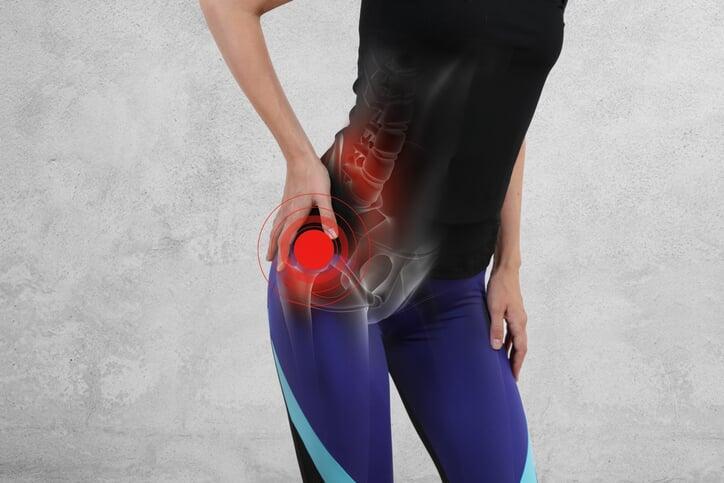Everything is connected!

Chronic hip pain can be a debilitating condition that significantly affects a person’s quality of life. Many individuals who experience ongoing hip pain find it difficult to perform everyday tasks, such as walking, sitting, or exercising, without discomfort. While traditional treatments such as medication, injections, or surgery are often considered, pelvic floor physiotherapy is an emerging approach that has shown promising results for managing chronic hip pain. This post explores how pelvic floor physiotherapy can help alleviate chronic hip pain, its benefits, and how it can be integrated into a comprehensive treatment plan.
Understanding Chronic Hip Pain
Chronic hip pain can be caused by a variety of factors, including osteoarthritis, hip labral tears, muscle imbalances, and previous injuries. The hip joint is a ball-and-socket joint that allows for a wide range of movement, making it susceptible to wear and tear over time. In addition to joint-related causes, chronic hip pain can also result from dysfunctions in the surrounding muscles, tendons, and ligaments.
One often-overlooked factor in chronic hip pain is the relationship between the pelvis, hip, and pelvic floor muscles. Dysfunction in the pelvic floor muscles can have a significant impact on the function and stability of the hip joint, exacerbating pain and limiting movement. Pelvic floor physiotherapy is a specialized form of physical therapy that targets the muscles, connective tissues, and ligaments of the pelvic region to restore balance, alleviate pain, and improve overall function.
The Role of the Pelvic Floor in Hip Pain
The pelvic floor is a complex network of muscles that supports the organs within the pelvis, including the bladder, uterus (or prostate), and rectum. These muscles also play an important role in stabilizing the pelvis and spine, and they interact closely with the muscles of the hips, lower back, and abdomen.
When the pelvic floor muscles become weak, tight, or imbalanced, they can affect the alignment and function of the pelvis and the surrounding structures, including the hips. For example, overactive pelvic floor muscles can create tension and misalignment in the pelvis, which places additional strain on the hip muscles and joints. On the other hand, underactive pelvic floor muscles may fail to provide adequate support to the pelvis, leading to instability that can increase the risk of hip pain or injury.
This relationship between the pelvic floor and hip function is why pelvic floor physiotherapy can be an effective treatment for chronic hip pain. By addressing pelvic floor imbalances, pelvic floor physiotherapy helps restore proper alignment and stability to the pelvis, improving the function of the hips and reducing pain.
Pelvic Floor Physiotherapy for Chronic Hip Pain: How It Works
Pelvic floor physiotherapy for chronic hip pain involves a combination of manual therapy, therapeutic exercises, and education to address the root causes of pelvic floor dysfunction and improve overall pelvic health. Here's how pelvic floor physiotherapy can help manage chronic hip pain:
- Pelvic Floor Muscle Assessment and Treatment
A pelvic floor physiotherapist will begin by performing a comprehensive assessment to evaluate the strength, tone, and function of the pelvic floor muscles. This assessment helps identify any areas of dysfunction, such as muscle tightness, weakness, or imbalance, that could be contributing to chronic hip pain.
Depending on the findings, the physiotherapist may use manual therapy techniques to release tension in the pelvic floor muscles or to activate weak muscles. For example, myofascial release or trigger point therapy may be used to release tightness and improve blood flow in the pelvic area. Manual therapy techniques can help reduce pelvic floor overactivity, relieve muscle tension, and allow the muscles to function properly.
- Core and Hip Strengthening Exercises
Pelvic floor physiotherapy also involves strengthening exercises to improve the support and stability of the pelvis and hips. A physiotherapist may recommend exercises that target the core muscles, including the abdominal and lower back muscles, as well as the hip stabilizers, to help improve posture and alleviate strain on the hip joint.
Strengthening the pelvic floor itself is also key to improving hip function. When the pelvic floor muscles are functioning well, they help stabilize the pelvis and provide better alignment for the hips. Exercises like bridges, clamshells, and pelvic tilts can help activate the pelvic floor muscles and support the hip joint. The therapist may also introduce breathing techniques to ensure that the pelvic floor muscles are engaging correctly during movement.
- Postural and Movement Education
A crucial part of pelvic floor physiotherapy is postural and movement education. Poor posture or faulty movement patterns can exacerbate hip pain by putting excessive strain on the hip muscles and joints. A physiotherapist will work with the patient to identify and correct these patterns, helping them to move more efficiently and without pain.
Postural retraining may involve educating patients on proper alignment during sitting, standing, walking, and exercising. By improving posture and adopting more functional movement patterns, patients can reduce the stress on their hips and pelvic region, leading to decreased pain and better overall function.
- Addressing Compensatory Patterns
Chronic hip pain can often lead to compensatory movement patterns, where other parts of the body take on additional strain to avoid aggravating the painful area. These compensations can create imbalances and even lead to secondary pain in other areas, such as the lower back or knees.
Pelvic floor physiotherapists help patients identify these compensatory patterns and work to restore proper movement mechanics. By addressing underlying muscle imbalances and improving coordination, pelvic floor physiotherapy can prevent further pain and improve mobility.
Benefits of Pelvic Floor Physiotherapy for Chronic Hip Pain
- Improved Pelvic Stability
By strengthening the pelvic floor and core muscles, pelvic floor physiotherapy helps improve pelvic stability. This stability is essential for proper hip function and can reduce strain on the hip joint, alleviating pain.
- Reduced Pain and Discomfort
Pelvic floor physiotherapy addresses the root causes of chronic hip pain, including muscle imbalances and dysfunction. By restoring balance in the pelvis and surrounding muscles, physiotherapy helps reduce pain and discomfort over time.
- Enhanced Mobility
As pelvic floor physiotherapy improves strength and function in the pelvic area, patients often experience increased mobility and flexibility in the hips. This allows for improved movement and less restriction, making it easier to engage in daily activities and exercise.
- Long-Term Management
Pelvic floor physiotherapy provides a non-invasive and sustainable approach to managing chronic hip pain. By teaching patients strategies for maintaining pelvic health and preventing further dysfunction, physiotherapy can offer long-term relief without the need for ongoing medication or surgery.
Conclusion
Chronic hip pain can have a significant impact on a person’s life, but pelvic floor physiotherapy offers a holistic and effective treatment option. By addressing pelvic floor muscle imbalances, strengthening key muscle groups, and improving posture and movement patterns, pelvic floor physiotherapy can help alleviate chronic hip pain and improve overall hip function. If you are struggling with chronic hip pain, consider consulting with a pelvic floor physiotherapist to explore how this specialized approach can benefit you.


